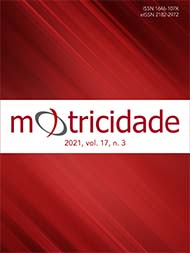Asymmetry in Parkinson’s disease and its relationship with strength
DOI:
https://doi.org/10.6063/motricidade.19649Keywords:
handgrip, isokinetic, Hoehn & Yard, handedness, substantia nigraAbstract
The onset side in Parkinson's disease remains unclear. Furthermore, the motor symptoms are typically unilateral, with the onset side often remaining more affected throughout the disease course. Therefore, as Parkinson's disease is an idiopathic disease, several questions are raised, one of them how the disease affects each person differently. For example, a person can be right-handed for the upper limb and left-footed for the lower limb, which can change strength scores. Thus, the aim of the study was to investigate the differences in muscle strength in people with Parkinson's disease, right-handed for upper limb and right-footed for lower limb, that have one most affected side, right or left side, on the upper and lower body. The sample consisted of 26 individuals diagnosed with Parkinson's disease, right-handed for the upper limb and right-footed for the lower limb. Subjects needed to visit the laboratory one time to assess handgrip and knee extensors strength. There were no differences between sides in upper limbs affected by the disease, and there were no differences between sides in lower limbs affected by the disease, p > 0.05. There were no differences in strength between sides of the same body part affected by the disease. To say that people affected on the determined side are weaker than others may be a misconception since Parkinson's disease is idiopathic.
Keywords: handgrip; isokinetic; Hoehn & Yard; handedness; substantia nigra
Downloads
Published
Issue
Section
License
The authors of submitted manuscripts must transfer the full copyright to Journal Motricidade / Sílabas Didáticas Editions. Granting copyright permission allows the publication and dissemination of the article in printed or electronic formats, and copyrights start at the moment the manuscript is accepted for publication. It also allows Journal Motricidade to use and commercialise the article in terms of licensing, lending or selling its content to indexation/abstracts databases and other entities.
According to the terms of the Creative Commons licence, authors may reproduce a reasonable number of copies for personal or professional purposes, but without any economic gain. SHERPA/RoMEO allows authors to post a final digital copy (post-printing version) of the article on their websites or on their institutions' scientific repository.


